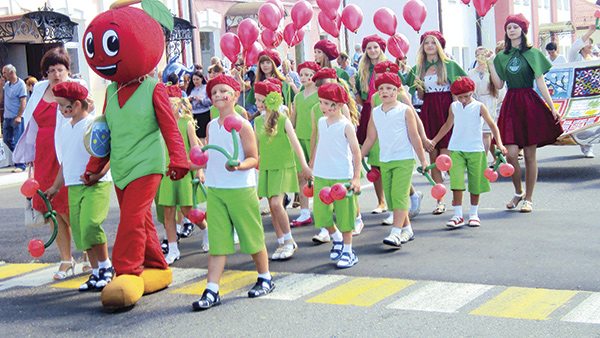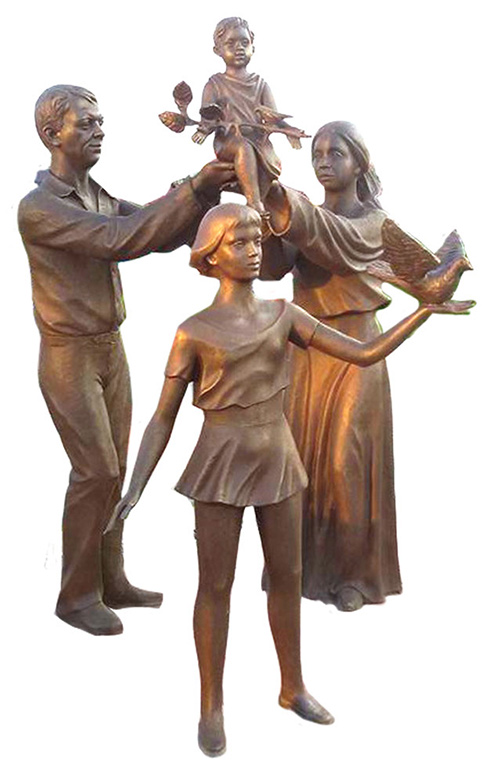Everyone knows about the Slavianski Bazaar, the IFMC Festival of Modern Choreography, and the music festival in memory of I. Sollertinsky. Belarus is rich in festivals. The Cherry Festival in Glubokoye is described by news agencies and tour operators as one of the country’s most authentic cultural events. Moreover, it has featured in the Top-10 most visited festivals in the country. It gained an international status long ago and this year saw participants from Russia, Latvia, Lithuania, Georgia, Moldova, Poland and Germany.

The cherry costume is the most popular during the festival
Cherry fun and frolics
Early in the 20th century, a landowner of Glubokoye, an agriculturist and breeder, Boleslav Lapyr, popularised frost-resistant sour cherries. Since then, the plants have been widely distributed among local households, making Glubokoye the ‘cherry capital’ of Belarus. Its Cherry Festival usually begins in mid-July and lasts for a week, including a colourful parade led by the Cherry Queen, and a conference on growing fruit, as well as various sporting events and amusing contests. There’s something for everyone: shooting with cherry pits, toe-wrestling, and racing in heels.
Snails are abundant in the cherry orchards of Glubokoye, so they also participate. This year, two full buckets of snails were brought to the central square, and their shells numbered. Crowds gathered excitedly to see which snail would first find its way out of the centre of a circle; they cheered on their ‘own’ snail and even cast bets. Of course, all the shelled participants were then released safely back into their orchard home.
Intriguingly, Glubokoye has a monument to Baron Munchausen and another, less surprisingly, devoted to its cherries. Legend has it that rubbing a granite cherry brings good luck, so all are well polished. This year, a new sculpture, entitled ‘Family’ was unveiled.
A major part of the festival involves trying delicious cherry pies, but guests can also buy handcrafted souvenirs and listen to live music. When I approached the main stage, spoon players from the Sverdlovsk Region of Russia were performing, followed by a folk group from the Georgian city of Telavi.
The chairman of the Telavi City Council, Archil Thlashidze, tells me that there are cherries in Kakheti but those in Glubokoye are perhaps the most delicious. He comments, “We made friends with Glubokoye three years ago, and today Glubokoye and Telavi are twin towns. Last year, we had only one representative, who participated in the accordion-playing contest; this year, we’ve brought two folk groups. The Investment Forum, traditionally held during the Cherry Festival, may result in our businessmen joining forces for construction and signing a profitable contract with a local timber company. They are seriously interested in Belarusian facade products.”

A monument to the family was unveiled during the festival
Economy and investments
While the Treaty of Amity and Co-operation between Glubokoye and Telavi was signed earlier, the administration of the rural settlement of Gremyacha, from the Osa Region of the Perm Krai of Russia, signed a similar bilateral agreement during the Investment Forum at the 4th Cherry Festival. The Russians liaised with organisers online, following the first cherry festival. The Investment Forum has also resulted in the signing of co-operative agreements between the Department of Culture of the Glubokoye Region Executive Committee with the Centre for Belarusian Culture of Daugavpils City Council (Latvia), and between the Glubokoye District Council of Deputies and the Švenčionys District Municipality (Lithuania).
According to Galina Unukovich, who chairs Glubokoye District Council of Deputies, the Glubokoye District is a keen member of the Euroregion ‘Country of Lakes’, promoting contacts between working groups across the Euroregion, as well as expanding co-operation between them in the Belarusian-Lithuanian-Latvian border area. She tells us, “Since 2001, we’ve implemented a number of major joint projects in the spheres of culture, business, and education, and have facilitated co-operation between the municipalities of border areas.”
She continues, “In the last three years alone, more than 180 million dollars have been invested in the development of the district’s economy. Our district is now a member of such international initiatives as the Local Environmental Action Plan for 2015-2020 and actions for the successful development of the Glubokoye District as a Belarusian territory of the Euroregion `Country of Lakes`”.
The European Union is funding an international technical assistance project and the Glubokoye District’s total budget is in excess of 7.5 bln non-denominated Roubles.
Some economic projects presented at the Investment Forum relate to cultural life, such as the creation of a museum gallery dedicated to Belarusian artist Fyodor Yastreb, who died in 2014. Meanwhile, the meat-processing plant has good prospects, branching into dairy farming, with interest shown from Israeli investors. The factory has its own equestrian club, maintaining close relations with colleagues from Russia and Latvia.
Glubokoye, with its forests and lakes, is a natural destination for tourists, and boasts a spa nearby, in the village of Plissa. Some diplomats like to go there to relax. The Plissa health resort presented a project at the Investment Forum, inviting funding to help with the construction of a new hotel and restaurant complex.
Glubokoye is going from strength to strength, building on the foundations of its orchards.
By Sergey Golesnik











